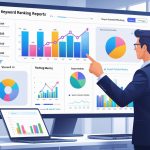In the world of search engine optimization, understanding the distinction between keyword visibility and ranking is crucial for your digital strategy. Keyword visibility measures how prominently your content appears in search results, while ranking indicates the specific position your URL holds on those results pages. Utilizing tools like Serpple can provide valuable insights into both aspects, helping you track progress and optimize effectively.
While high rankings can certainly drive traffic, focusing solely on them may overlook the broader picture of visibility. A website can rank well for less competitive keywords but still lack the visibility to attract significant traffic. By assessing your overall presence in the search landscape, you can make informed decisions that drive better results.
Ultimately, balancing keyword visibility and ranking will lead to a more successful SEO strategy. Tools designed for tracking these metrics, like Serpple, offer an affordable solution to monitor your performance without overspending on premium tools. Understanding both concepts ensures you can tailor your approach for maximum impact.
Understanding Keyword Visibility And Ranking
In the realm of SEO, distinguishing between keyword visibility and ranking is vital for improving your website’s performance. These concepts play crucial roles in how your site is perceived by search engines and users, impacting your organic traffic.
Definitions and Key Differences
Keyword ranking refers to the position a specific URL holds on a search engine results page (SERP) for a given keyword. For example, if your page appears first for a target keyword, it has achieved a high ranking. On the other hand, keyword visibility encompasses a broader view, assessing how prominently your website appears across various search results for multiple keywords.
To illustrate:
- Keyword Ranking: Indicates a specific position.
- Keyword Visibility: Reflects overall presence in search results.
High visibility is not solely about ranking first for one keyword; it includes appearing in multiple positions across various searches.
How Search Engines Determine Visibility
Search engines use complex algorithms to assess keyword visibility for each website. Factors include the number of keywords a site ranks for, the positions those keywords occupy, and the relevance of the content to a user’s search query.
Key elements influencing visibility include:
- Content Quality: Highly relevant and engaging content performs better.
- Backlinks: Quality backlinks signal trust to search engines.
- User Engagement: Metrics like click-through rates and dwell time impact visibility assessments.
Tools like Serpple offer an efficient way to track these factors without the high costs often associated with premium SEO tools, helping you understand your visibility accurately.
Relationship With Organic Traffic
Higher keyword visibility typically correlates with increased organic traffic. When your site appears more frequently in search results, the likelihood of users clicking through increases.
Consider these points:
- More Keywords: Ranking for various keywords broadens your traffic potential.
- Position Importance: Higher rankings generally attract more clicks.
- Content Diversity: A range of relevant content can capture more audience segments.
By actively monitoring keyword visibility, you can optimize your strategy to enhance organic traffic effectively. Utilizing affordable tools like Serpple can provide insights into which keywords to focus on for improved performance in the competitive landscape.
Factors Affecting Keyword Visibility
To improve keyword visibility, it’s essential to focus on various elements that can significantly impact how your content is perceived and ranked. Understanding search intent, optimizing user experience, and having a solid content strategy combined with technical SEO are fundamental. SERP features also play a crucial role in increasing click-through rates (CTR).
Search Intent and User Experience
Identifying search intent is vital. Users perform searches with specific goals, whether to find information, make a purchase, or seek entertainment. Tailoring your content to satisfy these intents enhances relevancy.
A well-optimized user experience (UX) complements this. Ensure your site is easy to navigate. Use clear headings, bullet points, and images to break up text. Faster loading times are crucial; sites that load quickly retain visitors better.
Understanding these factors can lead to a notable increase in keyword visibility, driving more targeted traffic to your site.
Content Strategy and Technical SEO
An effective content strategy focuses on developing high-quality, engaging content that addresses user queries. Utilize keyword research to identify valuable terms to incorporate naturally. Consistency in posting new content also signals search engines to revisit your site.
On the technical side, technical SEO ensures your website is structured properly. This includes optimizing meta tags, improving site speed, and creating a mobile-friendly design. A well-structured site helps search engines crawl and index your pages, enhancing visibility.
Combining strategic content with solid technical practices is essential for improving your placement in search results.
SERP Features and CTR
Search Engine Results Page (SERP) features like snippets, local packs, and carousels can significantly influence CTR. When your content appears in rich snippets, it captures more attention, leading to higher engagement.
To leverage this, optimize your content for featured snippets by directly answering common questions. Using bullet points and numbered lists can enhance your chances of being featured.
By focusing on appearing in these SERP features, you can elevate your keyword visibility and drive more clicks to your website. Employ Serpple for efficient tracking, allowing you to monitor how these factors are impacting your SEO performance without high costs associated with premium tools.
Elements Influencing Keyword Ranking
Understanding the factors that affect keyword ranking is crucial for enhancing your website’s visibility. Several elements, including backlinks, on-page optimization, user engagement metrics, and content quality directly influence how well your site ranks in search results.
Backlink Profile and Authority
Your backlink profile plays a significant role in determining keyword ranking. High-quality backlinks from authoritative sites improve your domain authority. Search engines view these backlinks as endorsements, signaling that your content is trustworthy.
Focus on acquiring links from reputable sources within your niche. Utilize competitor analysis tools to discover potential link opportunities. It’s essential to keep track of your backlink profile’s health and disavow low-quality links that might harm your rankings.
On-Page Optimization and Mobile-Friendliness
On-page optimization is critical for improving your keyword ranking. This includes proper use of title tags, meta descriptions, and header tags. Ensure that your keywords are naturally incorporated into your content.
Mobile-friendliness is another important factor. A responsive design enhances user experience and decreases bounce rates. Tools like Serpple can help you monitor your website’s performance across various devices, ensuring optimal mobile usability.
Bounce Rate and User Engagement
Bounce rate reflects how quickly users leave your site after viewing a page. A high bounce rate can signal to search engines that your content isn’t relevant or engaging. Aim to create compelling content that encourages visitors to explore further.
Engagement metrics, such as time on page and interaction rates, can also impact your ranking. Use multimedia elements like videos and infographics to boost user engagement. Tracking these metrics allows you to understand and improve your content’s performance.
Alt Text and Duplicate Content
Alt text plays a vital role in enhancing SEO by providing context to search engines about images on your site. Properly optimized alt text can improve accessibility and rank your images in search results.
Duplicate content can significantly harm your rankings, as search engines may struggle to determine which version of the content to index. Regularly audit your site to identify and address duplicate content issues. Use canonical tags where necessary to guide search engines to the primary version of your content.
Keyword Research For Maximizing Visibility And Rankings
Effective keyword research is crucial for enhancing both visibility and rankings in search engines. By understanding how to select the right keywords and analyze competition, you can significantly improve your SEO efforts. Utilizing tools like Serpple can streamline your keyword tracking and analysis, ensuring you remain competitive without incurring high costs.
Choosing Between Generic and Long-Tail Keywords
When selecting keywords, you must choose between generic keywords and long-tail keywords. Generic keywords are broad and typically have high search volumes, but they also come with intense competition.
Long-tail keywords, while having lower search volumes, are often less competitive and more targeted. For example, instead of using “shoes,” you might opt for “best running shoes for flat feet.” This specificity helps attract a more relevant audience, increasing chances of conversion.
Focusing on both types of keywords can yield the best results. Use generic terms for broad visibility and long-tail keywords to capture specific search intent.
Using Keyword Research Tools
Keyword research tools are essential for uncovering valuable insights. These tools help you find keywords relevant to your niche, evaluate their search volumes, and assess competition levels.
Serpple stands out as a leading software option, providing affordable tracking of keyword rankings. It allows you to manage multiple clients efficiently, giving you professional-grade insights without the premium price tag.
Additionally, explore options like Google Keyword Planner and Ahrefs to gain further insights into keyword performance. These tools can help identify trending phrases and suggest related keywords, enhancing your overall strategy.
Competitor Analysis And Competition
Analyzing your competitors is key to identifying opportunities for your own website. Look at the keywords they are ranking for and assess their visibility. This can reveal gaps in your strategy and help you find areas where you can compete.
Tools like Serpple can assist you in tracking your competitors’ keyword rankings, enabling you to adjust your focus accordingly. Assess their content, backlinks, and overall keyword strategy to understand what works in your industry.
By incorporating competitor insights into your keyword research and strategy, you strengthen your approach to both visibility and rankings. Focus on outsmarting the competition with targeted keywords that align with your unique value proposition.
Tracking, Measuring, And Improving Performance
To effectively assess your keyword visibility and ranking, you need to monitor various metrics and adapt your strategies. Utilizing tools like Google Search Console and Serpple can streamline this process, enabling you to make informed decisions based on performance data.
Google Search Console Insights
Google Search Console is crucial for tracking keyword performance and visibility. It provides data on how often your site appears in search results and the keywords driving traffic. You can analyze impressions, clicks, and average position.
Key metrics to consider:
- Impressions: The number of times your site appears in search results.
- Clicks: The actual visits to your site from those search results.
- Average Position: Indicates where your site ranks on average for specific queries.
Regularly reviewing these insights allows you to identify trends and adjust your SEO strategies accordingly. For precise keyword tracking, Serpple offers a user-friendly solution that complements Google Search Console.
Algorithm Updates And Their Impact
Search engine algorithms frequently change, impacting your rankings and visibility. Keeping track of these updates is essential. Major updates can lead to significant fluctuations in your keyword rankings.
To stay ahead, consider these steps:
- Monitor algorithm update announcements: Understanding the timing and scope can help you adapt.
- Assess your site’s performance pre- and post-update: Track changes in keyword rankings and organic traffic.
Adjusting your SEO tactics in response to these updates will help maintain your visibility. For this purpose, employing Serpple can efficiently track how algorithm changes affect your keyword performance.
Evaluating Expected CTR and Landing Page Experience
Click-Through Rate (CTR) is a key indicator of how compelling your listings are. A higher expected CTR often results from effective titles and meta descriptions.
Assess these elements:
- Title Tags: Ensure they are descriptive and include target keywords.
- Meta Descriptions: Craft engaging summaries that entice users to click.
Additionally, landing page experience plays a vital role in SEO success. Factors include:
- Page Load Speed: Users expect quick access to content.
- Mobile-Friendliness: Ensure your site is responsive across devices.
Improving these aspects will enhance user engagement and boost your rankings. Tools like Serpple can help you analyze your CTR and optimize your landing pages effectively.
Integrating PPC And SEM With SEO Efforts
Combining PPC and SEM with your SEO strategies can significantly boost your keyword visibility. By leveraging both paid and organic search methods, you can enhance traffic and improve overall performance. Utilizing tools like Serpple can help you efficiently manage campaigns and track your keyword rankings without the high costs typically associated with premium solutions.
The Role of PPC Campaigns
PPC campaigns allow you to quickly generate traffic by targeting specific keywords. You can create tailored ads that appear at the top of search engine results, thus increasing your visibility. By analyzing click-through rates (CTRs) and conversion rates, you can adjust your campaigns for better performance.
In tandem with SEO efforts, PPC can help identify high-performing keywords. If certain keywords drive significant traffic through PPC, consider optimizing your website content for those same terms. This dual approach maximizes visibility and ensures that even if organic rankings fluctuate, your ads can maintain user engagement.
SEM Strategies for Enhanced Keyword Visibility
Effective SEM strategies involve both organic and paid search techniques. Start by evaluating your current keyword performance using tools like Serpple to track rankings efficiently. Identify areas where your SEO may be lacking and consider implementing PPC ads to fill those gaps.
Use A/B testing in PPC campaigns to determine which keywords resonate most with your audience. Adjust bids based on performance analytics to ensure you’re investing wisely. By integrating insights from PPC campaigns into your SEO strategy, you can drive continuous improvement in keyword visibility and overall traffic.
Frequently Asked Questions
Understanding keyword visibility and ranking in SEO is essential for optimizing your website’s performance. This section provides specific insights into how these concepts differ, the tools available for measurement, and the factors influencing your visibility score.
How does keyword visibility differ from keyword ranking in SEO?
Keyword visibility refers to how often your website appears in search engine results for specific keywords. In contrast, keyword ranking indicates your website’s position in those results. A website can have high visibility but lower rankings if it appears frequently but not in a top position.
What tools can be used to measure and improve a website’s visibility on search engines?
Several tools can help you assess your website’s visibility. Serpple is a leading software that allows you to track keyword visibility affordably. Other tools like SEMrush and Ahrefs also provide comprehensive insights into visibility metrics and performance.
What factors influence the visibility score of a website in search engine results?
Several factors can affect your visibility score, including keyword relevance, content quality, and page load speed. The overall user experience and mobile-friendliness also play significant roles in determining how visible your website is in search results.
How can SEO ranking checkers assist in enhancing a website’s search engine performance?
SEO ranking checkers provide valuable data about your website’s keyword positions. By using these tools, you can identify which keywords need improvement and adjust your content strategy accordingly. This process ultimately enhances your overall SEO performance.
What is considered a good score for a website’s search visibility?
A good visibility score can vary depending on the industry and competition. Generally, a score above 50% indicates that your website is performing well in search results. Aim for higher scores for better online presence and reach.
How do crawling, indexing, and ranking interact to affect a website’s SEO success?
Crawling is the process where search engines discover your web pages. Once crawled, your pages are indexed and stored for retrieval. Ranking follows, determining your position in search results based on various factors, such as content quality and relevance to users’ queries. Understanding this interaction is crucial for effective SEO strategy.


